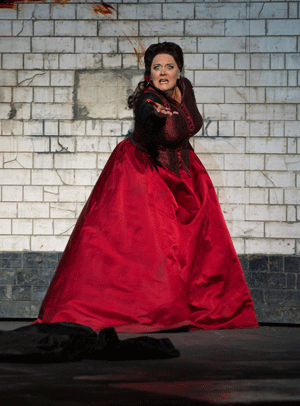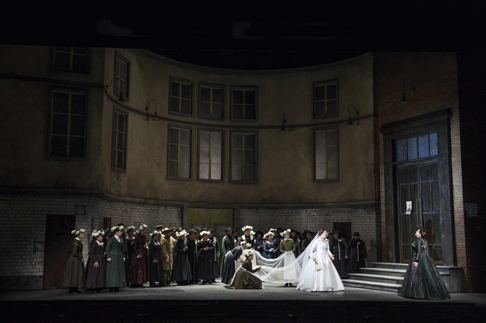03 Jun 2013
Lohengrin, Welsh National Opera
Wagner’s Lohengrin is not an unfamiliar visitor to the UK thanks, in the main, to Elijah Moshinsky’s perennial production at Covent Garden.

Wagner’s Lohengrin is not an unfamiliar visitor to the UK thanks, in the main, to Elijah Moshinsky’s perennial production at Covent Garden.
But this production apart, Wagner’s most romantic of operas is seen all too rarely, so it was a pleasure to be able to encounter Welsh National Opera’s new production directed and designed by Antony McDonald and conducted by WNO’s music director Lothar Koenigs. The production debuted at a Royal Gala at the Wales Millennium Centre in Cardiff on 23 May 2013. I saw it on 1 June.
WNO assembled a cast relatively new to Wagnerian drama rather than using seasoned Wagnerians. Peter Wedd sang Lohengrin, Emma Bell sang Elsa, Susan Bickley sang Ortrud, and Simon Thorpe sang Telramund (standing in for an indisposed John Lundgren). Bell has sung Eva at Covent Garden and has Elisabeth down on the cards, she has also been singing the title role in Fidelio. Wedd has a couple of Wagner roles under his belt (Froh, Amfortas), he has also been singing Florestan. Bickley generated many plaudits for her Brangane with WNO.
Wagner’s protagonists, Elsa and Lohengrin, are both young so having them incarnated by a pair of younger singers represents a dramatic advantage. But the title role in Lohengrin is a notorious graveyard for lyric tenors, requiring significant degrees of stamina and strength. So an exciting cast like this represents a challenge, a risk and a significant investment in the future by WNO.
As a designer/director Antony McDonald has a finely poetic eye and his production was both poetic and in many ways rather daring, mixing grim reality with magic and romance. He set it in the period of the opera’s composition in a 19th century militaristic society at war. Costumes were period, but the setting was a grim run down building, hardly a palace, this was a society on the edge, in the throes of war.
Act 1 took place in a sort of assembly hall, amphitheatre with the chorus raised above in seating, act 2 was in a courtyard of the building, with huge windows giving us a view of the interior of the building, the first scene of act 3 in a rather bleak room and the close of the opera in the same setting as act 1. The size and shape of the set not only gave space for seating for the large chorus, as well as providing focus for the voices. And, despite the grimness, McDonald and his lighting designer Lucy Carder created some moments of visual poetry.
McDonald’s act drop was a projection of romantic, misty landscape; there was another reality outside of Brabant. The two collided when Lohengrin appeared. Many directors choose to fudge the swan and the boat, but here McDonald introduced magic into his grim world. On Lohengrin’s first entry the doors to the amphitheatre swung open and a boat appeared, with a half swan, half body at the prow, Lohengrin behind him and the glimpse of a misty landscape in the distance.
Relatively slight of frame for a Wagner tenor, with bleached blond hair, and an outsize greatcoat over a linen martial arts tunic, and bare feet, Peter Wedd was every inch the enchanted outsider. The effect was magical and this was enhanced when Wedd sang his farewell to the swan, ‘Mein lieber Schwann’, producing some of the most enchanting Wagner singing I have heard in a long time.
Wedd does not have a huge voice and throughout the evening I was aware of him managing it. But he created a strong sense of ‘the other’, the strangeness of this knight from a foreign realm. At key moments his voice was suitably dramatic, the essential core of his voice has interesting dark, almost baritonal elements which are helpful in Wagner roles. In act 2, now equipped in a suit and properly fitting great-coat and shoes, he was properly authoritative. In the narration in act 3, the moment in the opera which is a true test of a tenor’s stamina, he was spellbinding. He started it as just an intimate talk with Elsa but slowly Wedd’s performance grew in power and intensity, to a thrilling climax. Wedd’s Lohengrin was not conventionally heroic and he does not have the ringing thrill of a traditional Siegfried, but intelligence and careful management of his voice ensured that his performance at the end of act 3 was as interesting as at the beginning.
Emma Bell was a warm, touching Elsa, radiant in her narration of the dream but perhaps really rather more maturely womanly than usual. She was certainly a rather stronger person than in some versions, but not less naive, Bell definitely created the impression in act 1 that Elsa was the sort of person who should really get out more. She had an almost evangelical belief in people and their goodness. In fact, in many ways both Elsea and Lohengrin were naifs, neither negotiating the complex society in ideal ways.
Certainly Lohengrin’s expectations of Elsa were unrealistic and in the long scene in act 3 when the denouement plays out, they were two people unused to personal relationships. Despite their professions of love, you just knew that had they succeeded in consummating their relationship it would have been awkward and tentative. This played out in the brilliant ebb and flow of the dialogue between Bell and Wedd, with first one then the other taking the lead and neither really understanding. The conclusion when it came was inevitable and heartbreaking.
Ortrud seems a role which Susan Bickley seems born to play. During the long act 1 proceedings, when Ortrud was present but silent, Bickley looked magnificent in a floor length coat (covering a fabulous full skirted red dress) and radiated superior disdain. This was an icy controlled Ortrud, spitting vitriol when she did let go.
 Susan Bickley as Ortrud
Susan Bickley as Ortrud
At the start of act 2, McDonald had Bickley and Simon Thorpe’s Telramund in what seemed to be a service courtyard of the building along with the rubbish. Whilst Ortrud harangued Telramund with her tongue, above we could see the shadows of Elsa and Lohengrin in the windows in public and private events in the palace. Bell sang her lovely act 2 solo from one of these windows and her dialogue with Bickley started with Bell leaning out of the window. Bickley was at her most seductive here, rarely can Ortrud’s music have been so beautifully sung, but with such control. Bickley showed us what this really cost Ortrud.
In a completely magical touch, McDonald showed Elsa in her bridal gown walking through the illuminated palace (the first floor windows now open) in a simple but lovely effect. Ortrud’s appearance in the procession, in a dark green shot silk gown with a bodice which looked like a breastplate, was a magnificent example of control and disdain. Her interruption of the bridal procession was superb in the concentrated hate and vitriol. Bickley’s voice is not of the huge dramatic mezzo type, but her wonderful laser focus ensured that every note counted.
Simon Thorpe was originally to play the Herald, but took over Telramund. He sang robustly, he was another naif, a bluff man who really did trust Ortrud. In the face of Bickley’s brilliant Ortrud, he did not stand a chance. Thorpe created a strong dramatic moment when he too interrupted the bridal procession to shout his own invective.
Matthew Best made a strong, robust King Henry, clearly shocked and bewildered at the goings on. Rhys Jenkins made a strong replacement as the Herald.
An additional palpable contribution to the drama was the chorus and they took advantage of the acoustic properties McDonald’s set to give us a superb series of chorus contributions. The people of Brabant were clearly a strong factor in the duchy. It is perhaps stereotypical to say that WNO is known for the excellence of its chorus, but excellent it was and thrilling too.
 Cast of Lohengrin
Cast of Lohengrin
Lothar Koenigs brought out both the beauty and the subtlety of the music and the drama. He had the many extra trumpets in the boxes, bringing thrilling drama to the ceremonial moments. The care that he took to support his cast should not be underestimated. The Wales Millennium Centre has a wide open pit but there was never a feeling of the principals having to strain to get over the orchestra. I did wonder whether tension sagged in the longer sections such as the middle of act 1, with Koenigs paragraphs not quite building to larger sections.
Despite the grim setting, there were many poetic moments with McDonald aided by Lucy Carter’s superb lighting. It is amazing how beautiful even the grimmest setting can be made to look.
I found the production to be utterly absorbing in a way that few recent Wagner productions have been. I look forward to hearing Peter Wedd and Emma Bell in more Wagner, but here with Antony McDonald’s intelligent production, Susan Bickley’s incredible Ortrud and supported by Lothar Koenigs, they brought a freshness to this most romantic of operas.
Robert Hugill
Production and cast information:
Herald: Rhys Jenkins, King Henry: Matthew Best, Telramund: Simon Thorpe, Elsa: Emma Bell, Lohengrin: Peter Wedd, Ortrud: Susan Bickley: Gottfried: Thomas Rowlands / Daniel Williams. Director & designer: Antony McDonald. Conductor: Lothar Koenigs. Lighting designer: Lucy Carter. Movement director: Philippe Giraudeau. Welsh National Opera at Wales Millennium Centre, Saturday, 1 June 2013.